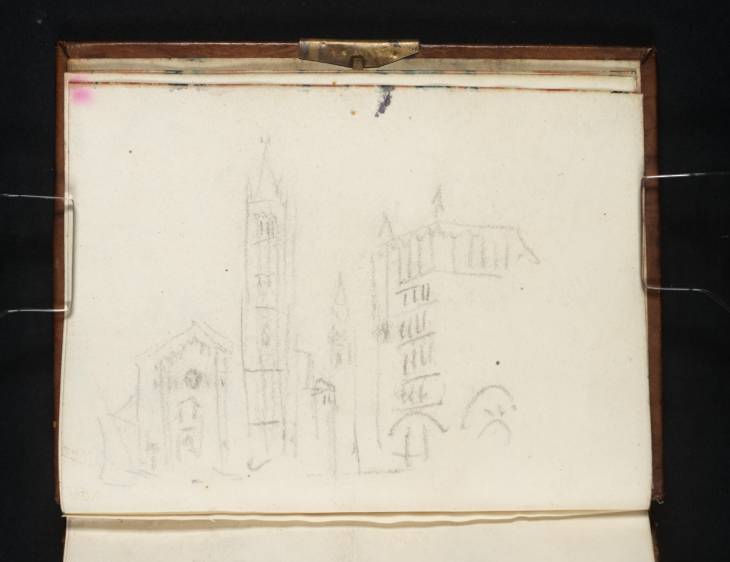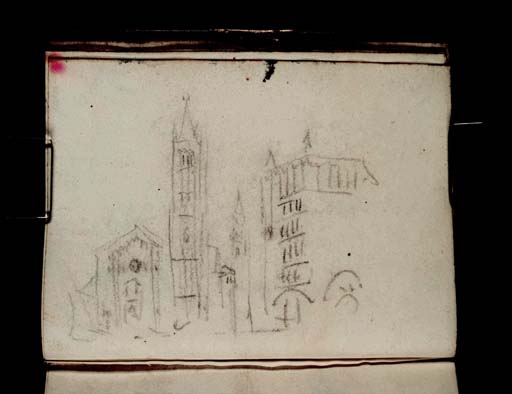Joseph Mallord William Turner The Duomo and Baptistery, Parma 1820
Image 1 of 2
Joseph Mallord William Turner,
The Duomo and Baptistery, Parma
1820
Joseph Mallord William Turner 1775–1851
Folio 5 Verso:
The Duomo and Baptistery, Parma 1820
D16650
Turner Bequest CXCII 5 a
Turner Bequest CXCII 5 a
Pencil on white wove paper, 98 x 128 mm
Accepted by the nation as part of the Turner Bequest 1856
References
1909
A.J. Finberg, A Complete Inventory of the Drawings of the Turner Bequest, London 1909, vol.I, p.571, as ‘Buildings and Campanile (possibly at Milan)’.
1984
Cecilia Powell, ‘Turner on Classic Ground: His Visits to Central and Southern Italy and Related Paintings and Drawings’, unpublished Ph.D thesis, Courtauld Institute of Art, University of London 1984, p.432, as ‘The cathedral and baptistery at Parma’.
As the art historian and Turner scholar Cecilia Powell first identified, the subject of this sketch is the Duomo (cathedral) and Baptistery at Parma.1 The artist passed through the city as part of his return journey between Florence and Milan, opting to take the road via Bologna, Modena, Reggio dell’Emilia, Parma and Piacenza. His outward itinerary had comprised a different route between Milan, Venice, Bologna and Ancona, and therefore this represented his first time in Parma, a city notable for its architectural treasures. Turner had made notes concerning the most famous sights including the cathedral in the Italian Guide Book sketchbook (Tate D13938; Turner Bequest CLXXII 4). Further relevant guidance was provided by James Hakewill (1778–1843) in the Route to Rome sketchbook (Tate D13897; Turner Bequest CLXXI 21) and on a separate sheet of paper (see Tate D36333; Turner Bequest CCCLXVIII B). Turner appears to have stayed in the city for at least a night or two, making a number of topographical drawings, see folios 5 verso–10 verso (D16650–D16660). These studies are generally rougher and freerer in appearance than similar subjects from other Italian towns such as Milan, Turin, Venice or Florence.
Turner’s viewpoint for this sketch is the Strada al Duomo, a street leading up to the south-west corner of the piazza in front of the cathedral. The Romanesque Duomo itself appears on the left-hand side of the composition with its adjacent thirteenth-century campanile, while the twelfth-century octagonal Baptistery is situated on the right. Visible between the two buildings is the bell-tower of the Church of San Giovanni Evangelista. Further sketches related to the Duomo, including some depicting the interior, can be found on folios 8 verso–10 verso (D16656–D16660).
Finberg notes that a leaf has been torn out after this point in the sketchbook.2
Nicola Moorby
April 2013
How to cite
Nicola Moorby, ‘The Duomo and Baptistery, Parma 1820 by Joseph Mallord William Turner’, catalogue entry, April 2013, in David Blayney Brown (ed.), J.M.W. Turner: Sketchbooks, Drawings and Watercolours, Tate Research Publication, August 2013, https://www


